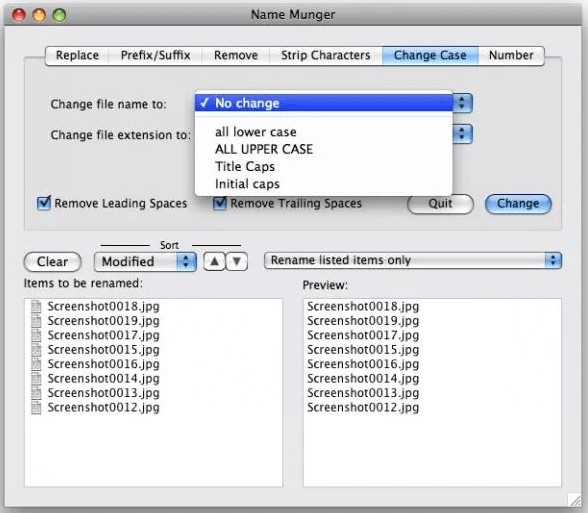

Renamer is a batch file renaming app for macOS that allows you to rename lots of files quickly and conveniently. Open Automator, located in your Mac’s Applications folder and select New. If you are on prior to the Yosemite (Mac OS 10.10) version, you will require using a built-in tool like Automator to first create a workflow to batch rename files. You can have filenames ending or starting with a counter (0001) or date or just a simple 1,2,3 format. The best batch file renamer just got a whole lot better with Renamer 6. Batch Rename Files on Mac Using Automator. You have options to choose Format, Add Text, and Replace text.įormat: When you want to completely rename the files, add a number in the front, and have similar names, you should choose it.Its great to actually have such advanced file renamer built into the OS. This will open a pop-up menu which gives a plethora of options to rename the files.

XX will be the count of files you have selected. You can also click on File on the menu bar and reveal the Rename xx items. How t0 rename the file using PowerShell: PowerShell offers even more flexibility for renaming files in a command-line environment. Press control and click any of the files. Save as rename.bat Execute the file and the file TESTA.txt will be changed to TESTB.txt The batch files can be used for many other simple actions like to delete files in bulk or to delete folders.Select the files you want by using command or use the cursor.
#How to batch rename files on mac os x how to#
How to rename multiple files in Mac OS X in one go Surely you already know many of the ways to organize folders and files on Mac computers, but there is one aspect that you may not have known and can be very useful.
#How to batch rename files on mac os x download#
The download folder or desktop has a lot of files, and you would not want to accidentally rename files which you had accidentally selected. This will reduce the clutter, and also the confusion. Just before you start, I would strongly suggest you copy all your files into a separate folder. In this post, I will share how to rename multiple files in Mac OS X. While Mac OS X lets you quickly rename a file when you select and hit enter, renaming multiple files is not that straightforward. My default max limit is acually unlimited right now when I run launchctl limit maxfiles but I'm going to err on the side of sticking to the instructions provided from basho.Renaming files after downloading a bunch of them from the internet or your Mail account is very common. The gist this was forked from set the macproc to 2048 which is lower than my current default 10240, so I'm not going to modify that for now. I'm no expert on this stuff, but maybe it sounds reasonable to you too.ġ2288-2048=10240 (soft limit) (Oh hey what do you know - this is the same number as the kern.maxfilesperproc). For a soft limit, I think subtracting 2048 seems fair also. This seems like a fair max limit given my minimal research on this issue. I would presume this might be the kernels max capacity (probably guesstimated by apple, but still, I have to respect apple's settings). How I modified limits for my 2013 Macbook air (running sierra): run sysctl -a | grep kern.maxfiles this may show you: kern.maxfiles: 12288 If your system is configured correctly, you should see that maxfiles has been set to 200000. At this point, you can restart your computer and enter ulimit -n into your terminal. Like the plist files, your bashrc or similar file should have -rw-r-r- permissions. In addition to setting these limits at the system level, we recommend setting the at the session level as well by appending the following lines to your bashrc, bashprofile, or analogous file: While the steps explained above will cause system-wide open file limits to be correctly set upon restart, you can apply them manually by running launchctl limit. This permissions should be in place by default, but you can ensure that they are in place by running sudo chmod 644. Both plist files must be owned by root:wheel and have permissions -rw-r-r.


 0 kommentar(er)
0 kommentar(er)
